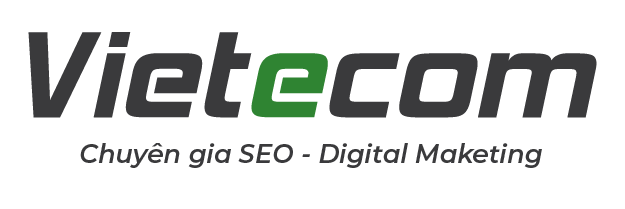Having a strong presence in search engines can effectively grow your Fintech business online.
Implementing effective SEO strategies is essential to stand out from the crowd and ensure your fintech tool reaches your target audience.
This article will explore the basics of fintech SEO and provide actionable steps to position your fintech tool in search results.
Let’s begin!
What is SEO in Fintech?
Fintech SEO refers to the optimization techniques used to improve the visibility and ranking of fintech websites on search engine results pages (SERPs).
By leveraging SEO strategies, fintech companies can attract organic website traffic and increase their chances of converting visitors into customers.
Fintech SEO involves various tactics, such as:
- keyword research,
- on-page optimization,
- off-page optimization,
- technical SEO,
- content strategy,
- and user experience optimization.
These strategies work together to enhance the overall online visibility of your fintech tool.
Now, let’s delve deeper into the world of fintech SEO and explore the various tactics involved in optimizing your fintech website.
Why is SEO Important for Fintech Companies?
With the highly competitive fintech industry, having a strong online presence is crucial.
Some of the most important benefits of Fintech SEO are:
- Search engine rankings – By investing in SEO, fintech companies can improve their rankings and gain a higher visibility on search engines. This translates into increased brand awareness, website traffic, and potential leads for your fintech tool.
- Attract targeted organic traffic – By optimizing your website, you can attract highly targeted organic traffic that is more likely to convert into customers. This helps increase the overall conversion rate and improves your return on investment (ROI).
- Long-term traffic benefits – Unlike paid advertising, which stops generating traffic once the budget runs out, SEO efforts continue to yield results over time. By consistently optimizing website and producing valuable content, you can establish a strong online presence that continues to attract organic traffic and generate leads even in the long run.
Key Elements of Fintech SEO
Now that we understand the importance of SEO in the fintech industry let’s explore the key elements that are essential for successful fintech SEO.
1. Conduct Keyword Research for Your Fintech Tool
Keyword research is the foundation of any SEO strategy.
By identifying the right keywords, you can optimize your website content to match the intent of your target audience better.
This helps search engines understand the relevance of your website to specific search queries, increasing the likelihood of your website appearing in relevant search results.
When performing keyword research for fintech, it’s important to consider the specific terms and phrases that potential customers will likely use when searching for fintech solutions.
This could include keywords such as “fintech software,” “online banking solutions,” or “digital payment platforms.”
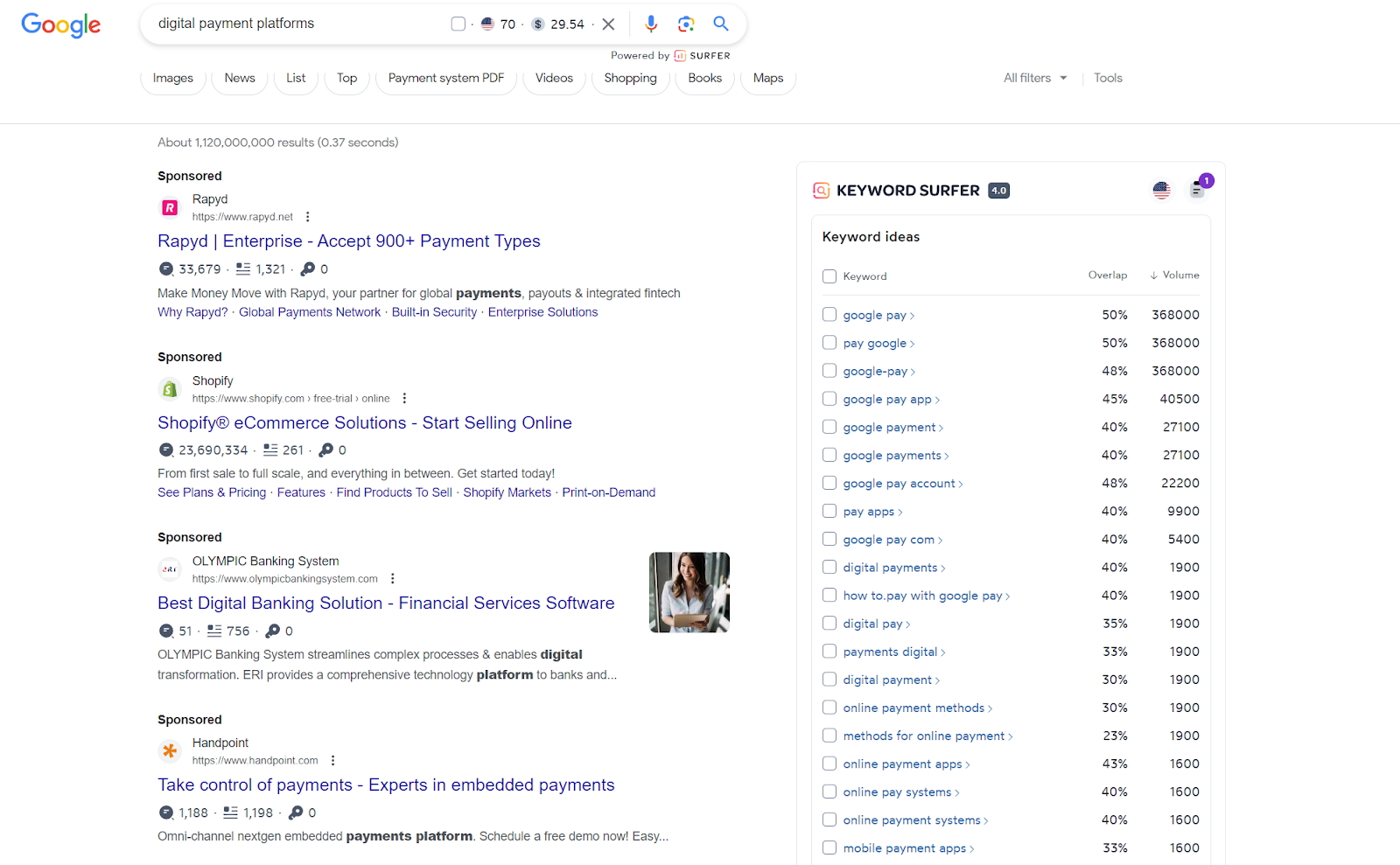
Conduct thorough keyword research to uncover the most relevant and high-traffic keywords related to your fintech tool.
You can use any free keyword research tool, such as Google Keyword Planner, Keyword Tool, or some of the paid ones, if you want to get more keyword ideas in one place.
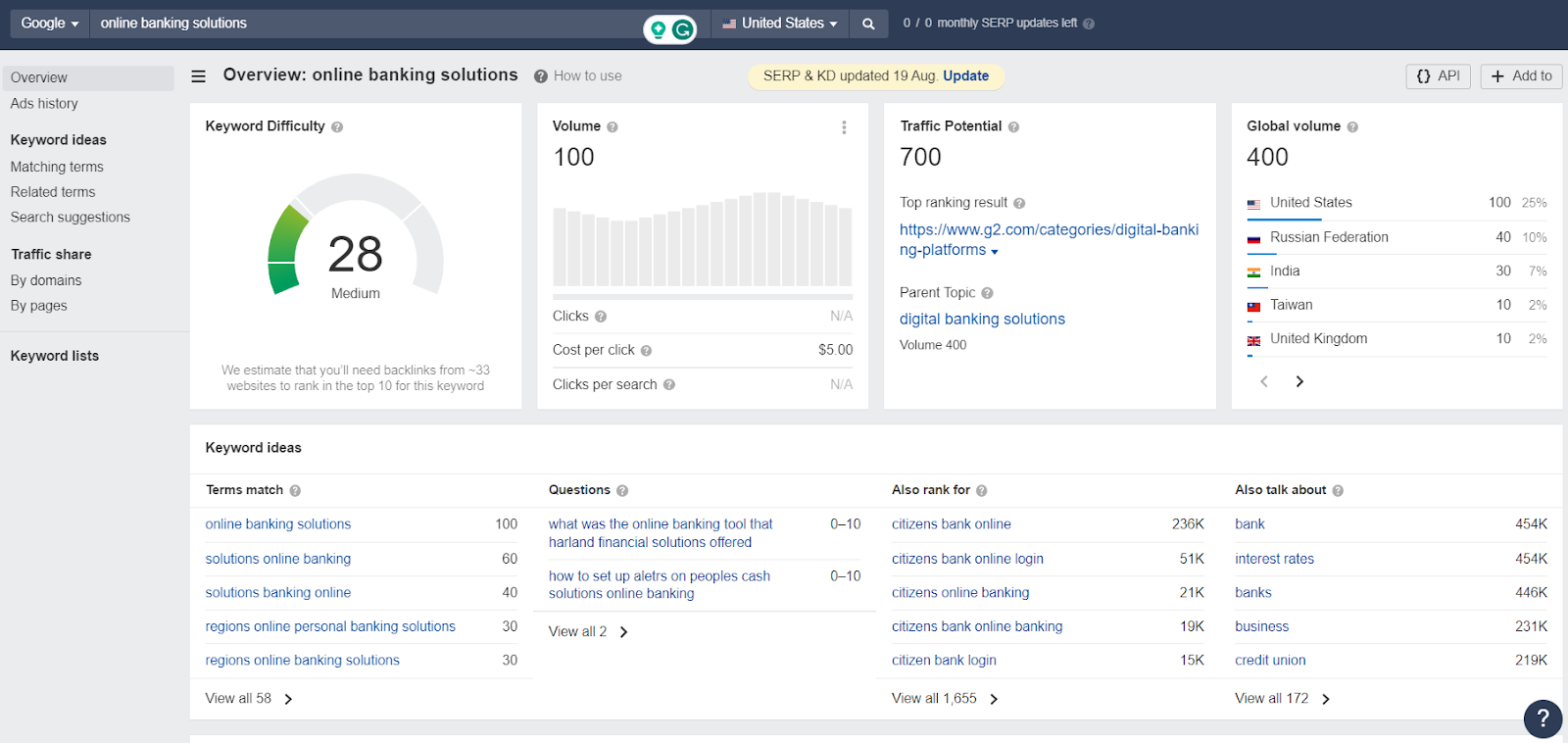
By understanding the language and terminology used in the industry, you can create content that aligns with user intent and attracts qualified traffic.
2. Use Best On-Page SEO Practices To Optimize Pages
On-page SEO is a set of optimization tactics that you should implement on each page to improve your rankings.
Even simple tactics and small steps can boost search traffic to your fintech website.
To optimize your fintech website effectively, you must pay attention to on-page SEO factors.
This includes optimizing page titles and meta descriptions, content on pages, URL structure, and incorporating relevant keywords throughout the content.
So how to do it?
Here are some actionable tips to implement straight away.
Create Unique Page titles and meta descriptions
When optimizing your page titles and meta descriptions, ensure they accurately reflect each page’s content while incorporating relevant keywords.
This helps search engines understand the context of your pages and improves click-through rates from search results.

Here are some tips to help you optimize them:
- Include the target keyword close to the beginning of page titles
- Include emotional keywords that make your titles unique
- Keep your titles between 30 to 55 characters for the best CTR
- Include numbers and make your titles actionable
- Include CTAs within the meta descriptions
- Make your meta descriptions persuasive
- Keep your meta descriptions between 120 and 150 characters
Optimize your URL structure
URL structure is another important on-page SEO factor.
Creating descriptive and keyword-rich URLs can improve the visibility of your fintech website in search results.
For example, instead of using a generic URL like “https://yourwebsite.com/page1,” consider using a more descriptive URL like: “https://yourwebsite.com/fintech-software-solutions.“
Here are some tips to make your URLs optimized:
- Keep your URLs descriptive to reflect the content of the page accurately
- Keep the URLs short, as they tend to perform better
- Avoid special characters and numbers
- Include targeted keywords within the URLs
- Avoid stopping words such as “the,” “and,” “of”, to make them more concise
- Use subdirectories for categorization, such as “/products/” for product pages
Including these tips in your URL structure will make your website one step ahead for better positioning in search results.
Optimize your content for the best performance
Even simple strategies can boost search traffic to your fintech brand.
Whether it’s a blog post, service page, or even the homepage, using on-page techniques is critical.
Furthermore, organizing your content with headings and subheadings enhances readability and signals to search engines the main topics covered on your page.
Here are some easy ways to do it:
- Make sure your page loads fast
- Place the target keyword in the first 100 words of content
- Have only one H1 heading per single page
- Place the target keywords in H2 headings where relevant
- Make a title and headings to be descriptive
- Create your content to be informative, readable and actionable
- Link to other pages on your website where possible
- Include a valid schema markup for your pages
Additionally, ensure that your content is well-structured, engaging, and includes relevant keywords to improve its search engine visibility.
By following these on-page optimization practices, you can ensure that your fintech website is easily discoverable by both, search engines and users.
3. Off-Page SEO Techniques for Fintech
Off-page SEO refers to the actions taken outside of your website to improve its search engine rankings.
This involves building high-quality backlinks from reputable websites, engaging in influencer marketing, and promoting your fintech tool on social media platforms.
These backlinks act as votes of confidence for search engines, indicating that your website is a trusted source of information.
By improving your website’s authority and credibility, off-page SEO techniques can boost your overall search visibility.
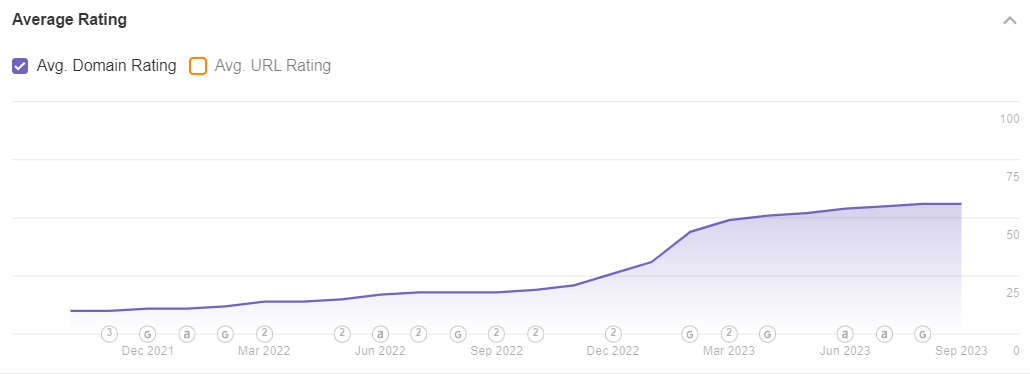
Seek opportunities to collaborate with industry influencers, guest post on relevant blogs, or participate in industry forums to earn valuable backlinks.
1. Partnering with different businesses
Partnering with businesses that have a strong online presence in the financial technology space can help increase brand awareness and drive traffic to your website.
Their endorsement of your fintech tool can generate valuable backlinks and social media mentions, further enhancing your search engine visibility.
Here are some actionable steps to help you achieve this:
- Identify relevant backlinks and websites – Begin by identifying potential websites in your niche or industry that have an engaged and relevant audience. You can look for influencers who align with your brand and target audience.
- Research their content – Study the content created by these influencers. Identify the topics and types of content that resonate most with their audience to help you tailor your approach.
- Create high-quality content – Develop valuable, informative, and engaging content that is related to the influencer’s niche or interests. This could be a blog post, infographic, video, or any other content format.
- Reach out with a personalized pitch – Craft a personalized outreach email or message to the influencer and make sure to highlight the mutual benefits and clearly state the offering.
- Offer value, not just backlinks – Make it clear that you’re not just seeking a backlink but are interested in providing value to their audience. Show how your content will enhance their content strategy.
Make sure to promote the collaboration on your social media channels, website, and email newsletters to maximize exposure.
Encourage the businesses and websites to do the same so you can reach their audience.
4. Keep Your Technical SEO at Point
Technical SEO focuses on the technical aspects of your website to improve its crawling, indexing, and overall performance on search engines.
This includes optimizing your website’s loading speed, mobile-friendliness, XML sitemap, implementing structured data markup, etc.
Here are a few steps on how to optimize different technical elements on the website:
1. Ensure your website is responsive and mobile-friendly – Use a tool such as Google Mobile-Friendly Test to see if your website is responsive, and fix the issues if it’s not.
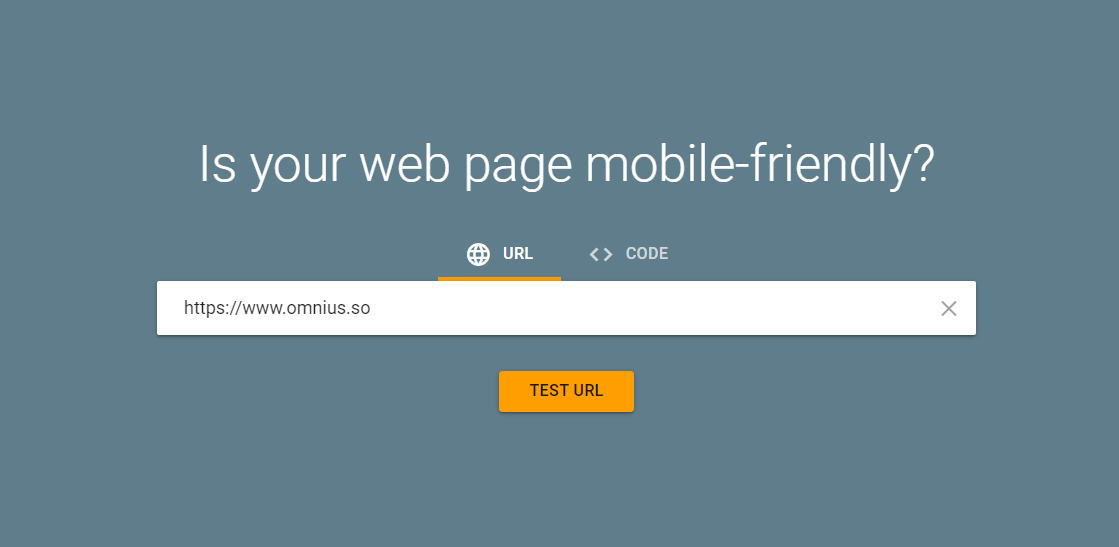
2. Optimize your website’s loading speed – Use tools like Google PageSpeed Insights or GTMetrix to identify and fix issues that slow down your site.
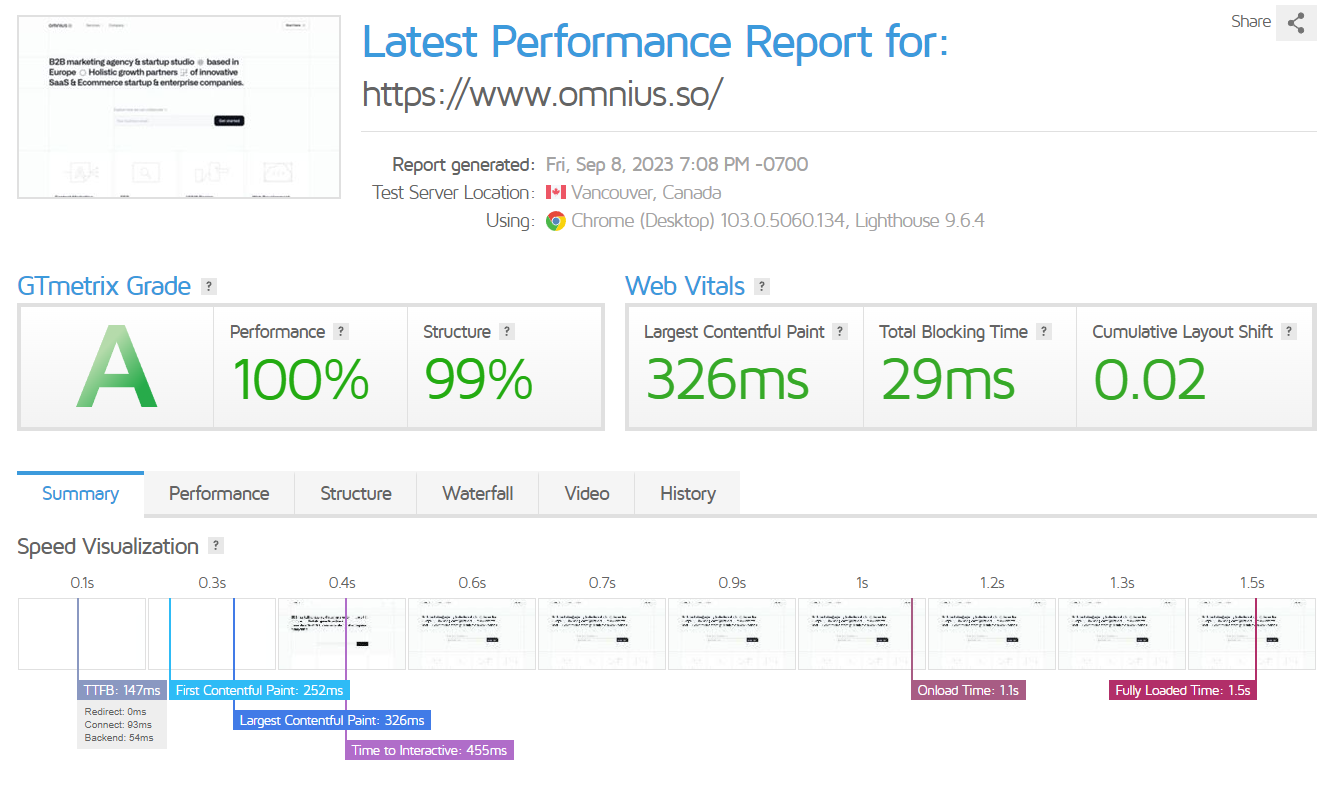
3. Optimize Images – Compress images to reduce file size without sacrificing quality, and use descriptive file names and alt text for images to improve accessibility and SEO.
4. Create and submit an XML sitemap to Google Search Console to help search engines understand your website’s structure and content, making it easier for them to crawl and index.

5. Optimize your robots.txt file to control which parts of your website search engines can crawl and index, and ensure that important pages are not blocked.
6. Use canonical tags to specify the preferred version of duplicate or similar content, which helps prevent duplicate content issues.
7. Implement structured data markup to provide search engines with additional context about your content, which enhances rich snippets and can improve click-through rates.
8. Regularly check for and fix broken links (404 errors) where tools like Screaming Frog can help identify these issues.
9. Ensure a logical and user-friendly website navigation structure to make it easy for both users and search engines to find and access important pages.
5. Create a Comprehensive Content Strategy
No one wants to read too technical, boring content full of fluff and unnecessary terms.
And in the fintech niche, that’s quite common.
Developing a comprehensive content strategy is essential for fintech SEO success.
You can attract and retain your target audience by creating high-quality, informative, and engaging content that is easy to understand.
By consistently producing valuable content, you can position your fintech company as a thought leader in the industry and attract organic traffic to your website.
This includes creating blog posts, articles, whitepapers, and other forms of content that address your target audience’s pain points and challenges.
So how to create your content strategy?
Suppose you own a business such as Stripe – which is a payment processing solution
You might probably want to target BOFU keywords as they’re proven to convert better.
Let’s say one of those keywords is “stripe vs paddle.”
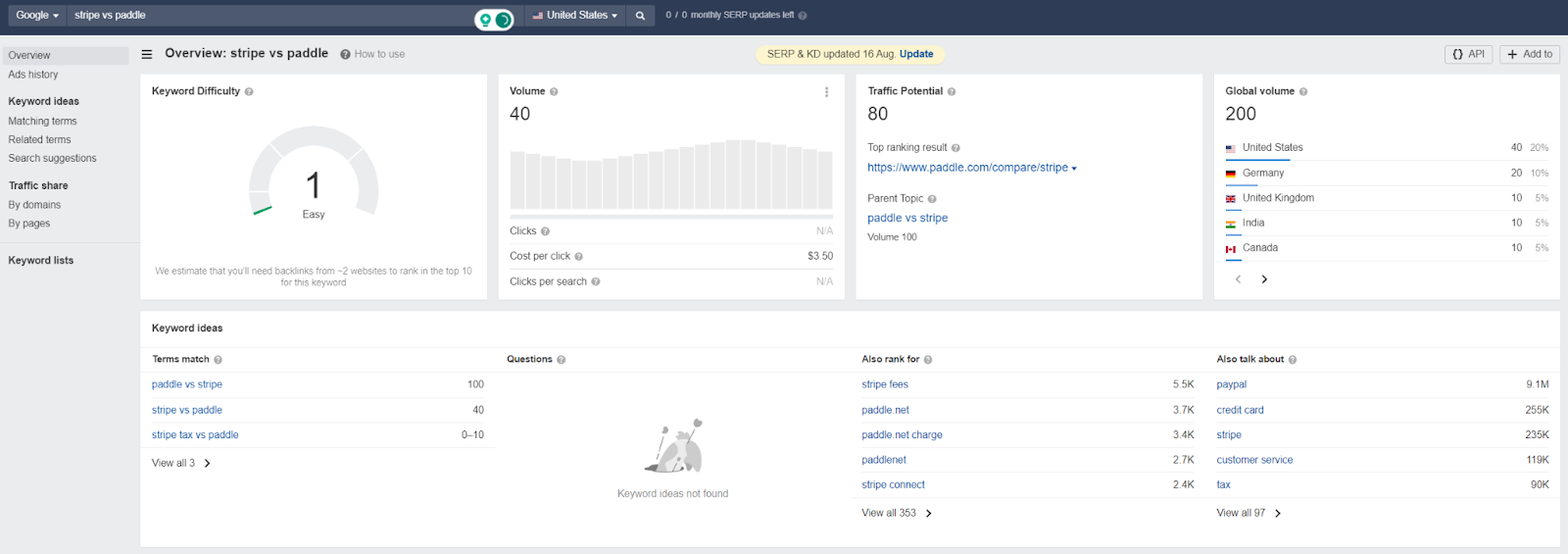
As you can see, the search volume of this keyword is not that high.
People searching for this keyword are more likely to convert into paying customers as they search for payment solutions.
What’s great is that this keyword is pretty easy to rank since the keyword difficulty is one.
And there are hundreds and thousands of keywords like these that you can target.
But how to know which ones to target?
Understand your customers’ pain points – it will lead you to the high-intent keywords and converting topics.
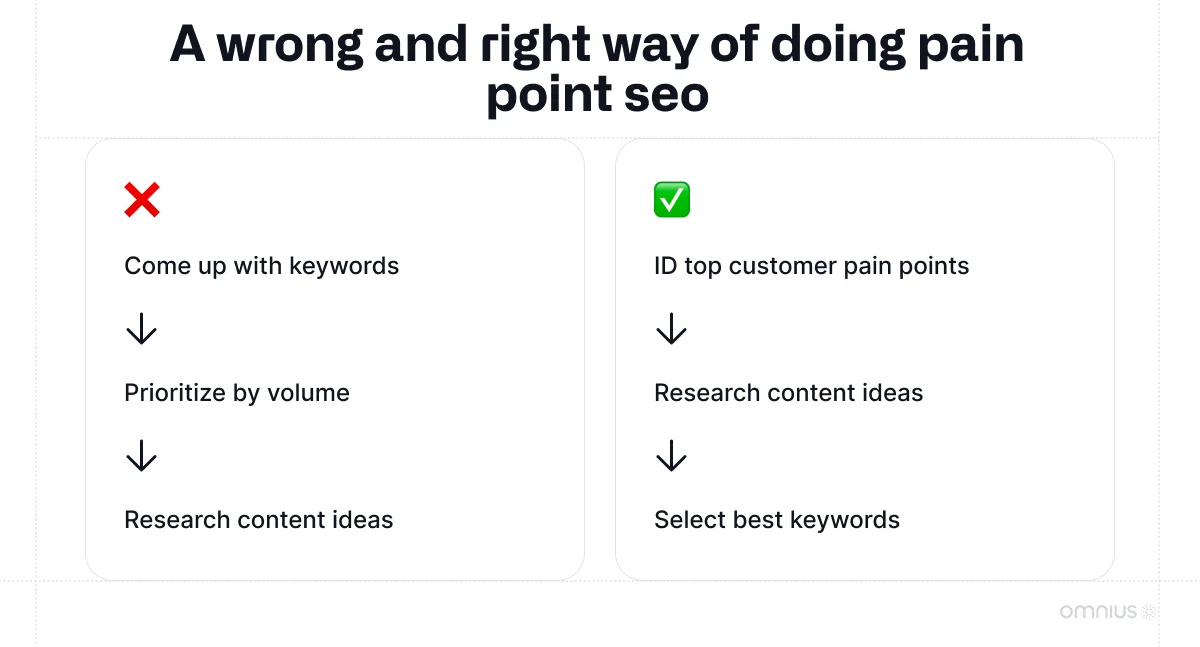
Targeting any keyword that fits your target persona and is relevant to their search intent is worth every penny.
Based on identifying pain points, make sure to research content ideas and select the most relevant keywords for your business.
Different pages convert best, such as:
- Pricing pages (e.g. paddle pricing)
- Comparison posts (e.g. stripe vs paddle, paddle vs stripe)
- Alternative pages and articles (e.g.stripe alternatives, paddle alternatives)
- Best of X (best payment processing solution)
- Use cases
Just by listing all the competitors in a single place and researching keywords as mentioned above, can give you tons of high-converting topic ideas.
Ensure to incorporate relevant keywords strategically and consistently produce fresh content to keep your website updated.
And don’t focus only on BOFU content. Make some percentage of it be MOFU and TOFU content.
6. Track and Improve Your Fintech SEO Performance
Tracking your fintech SEO performance is crucial to understanding the effectiveness of your strategies and making necessary improvements.
Let’s explore key steps for tracking and improving your fintech SEO performance:
- Conversions tracking – Use Google Analytics to track conversions, such as form submissions, sign-ups, or downloads, and make sure to set up conversion goals to measure the success of your SEO efforts in terms of lead generation or revenue.
- Traffic Analysis – Analyze organic traffic sources and user engagement metrics in Google Analytics.
- Keyword Tracking – Monitor your target keywords’ rankings regularly using SEO tools like SEMrush, Ahrefs, or Moz and track how your rankings evolve over time to identify trends and opportunities.
- Content Performance – Identify high-performing and underperforming content on your website. Evaluate which pieces of content are driving the most traffic and conversions.
- Backlink Monitoring – Keep an eye on your backlink profile to ensure the quality and relevance of inbound links. Monitor for any toxic or spammy backlinks that may harm your SEO.
- Heatmaps and User Session Recording – Use tools like Hotjar or CrazyEgg to analyze user behavior on your website through heatmaps and session recordings.
Make sure to analyze your performance on a constant basis so you can double down on tactics that bring fast growth and conversions.
7. Update Your Content Regularly
You should keep your website and blog up-to-date with fresh content.
Regularly publishing new articles, updates, and insights to show your expertise in the fintech industry will help you convert easier and keep visitors returning for more.
But it’s important to get back to existing content and update it occasionally based on data gathered.
How to update content to maximize traffic and conversions?
Here are a few steps:
1. Improve articles and pages with the greatest conversion potential
To find the articles and pages with the greatest conversion potential, follow these steps:
- Go to GA4 and identify content that brought conversions historically
- Identify content where conversions have fallen YOY or QOQ
- Identify BOFU content that should be bringing in conversions
Note all those pages and articles, and prioritize the updates based on the ones that have the greatest drop-off in conversions.
Make sure to identify what can be improved to improve conversions.
2. Search for traffic drop pages and search volume opportunities
To find the pages and articles with the greatest drop, here are the following steps:
- Enter the GSC and find pages with traffic drop YOY or QOQ
- Note those pages and see if their CTR dropped
Make sure to optimize the content, meta titles and description, improve and shorten introduction, optimize content for featured snippets, and see if something else can be improved.
3. Optimize “Quick wins” topics
Quick win topics are usually considered to be the ones that already rank but are not in the top 3 positions.
Those are usually pages and articles from 4-20 positions.
These pages have a great potential to rank higher, and they can require even a few minutes of work to boost those rankings.
Use a tool such as GSC or Ahrefs to identify these low-hanging fruits and optimize the content to be better than the top 3 results.
Note: If you can find topics and pages that exist in more than one of these groups, make sure to prioritize them, as they can bring the greatest impact.
Wrapping Up
As search engine algorithms evolve and competition intensifies, you must continually improve your fintech SEO strategies.
By understanding the fintech SEO, optimizing your website, and tracking your SEO performance, you can elevate your company’s online visibility and attract more users to your fintech tool.
Knowing how to implement SEO into your fintech website requires a specialized team to handle all the required tasks.
Or you can let Omnius handle that for you.
Cause we spend years testing what performs and know exactly how to implement it for any fintech business.
Interested to hear more about it?
Book a 30-minute free consultation to find out how to implement an SEO strategy that brings at least over 50% monthly organic growth to your business.
FAQ
What is SEO in fintech?
SEO in fintech refers to Search Engine Optimization practices specifically tailored to the financial technology industry.
It involves optimizing online content and websites to improve their visibility on search engines like Google.
This helps fintech companies rank higher in search results, driving organic traffic and potential customers to their digital platforms.
How do you promote a fintech product?
Promoting a fintech product involves a multi-faceted approach.
It includes creating engaging and informative content to showcase the product’s benefits, leveraging social media marketing, partnering with industry influencers, participating in fintech events, and employing targeted advertising.
Effective promotion can help gain customer trust and expand the product’s user base.
What is the go-to-market strategy of fintech?
The go-to-market strategy of fintech companies involves planning and executing steps to successfully introduce their products or services to the target market.
This typically includes market research, identifying target audiences, crafting compelling value propositions, establishing distribution channels, pricing strategies, and marketing campaigns.
The goal is to position the fintech offering effectively, differentiate it from competitors, and drive customer adoption and growth.
Nguồn: omnius.so
